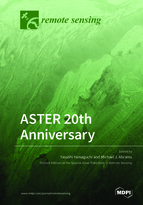The Spatial and Spectral Resolution of ASTER Infrared Image Data: A Paradigm Shift in Volcanological Remote Sensing
Round 1
Reviewer 1 Report
Dear Editor,
I read with interest the Review Paper entitled “The spatial and spectral resolution of ASTER infrared image data: A paradigm shift in volcanological remote sensing” submitted by M.S.Ramsey and I.T.W. Flynn. The Authors shown a clear and appropriate review of the ASTER data applied in volcanology describing the operational (STAR and URP) and volcanological results issued by ASTER images. These results spanning from morphological analysis (DEM) to variation of analyzed parameters of volcanic activity (Brightness Temperature), coupled by significant contribution on detecting and tracing volcanic plumes. Moreover, the Authors discuss the improvement that could be support the volcano monitoring by a space-sensor having the spatial and spectral resolution of ASTER with a daily frequency overpass (e.g. MODIS, VIIRS).
The paper is clear, well written and satisfy the great quality of your journal. Consequently, after the minor revisions, the paper can be published by RS in Review Paper section.
Methods
The Authors have to remind the spectral and spatial resolution of the sensor. Probably the better solution is to add a Table where are showed the wavelength and the spatial resolution of each band(s).
Line 242-311 I really appreciate the focus of this paragraph and, in my opinion a Table displaying the different web address cited therein and the relative dataset, including timespan and products, related to ASTER images.
Results
In order to outline the different volcanological contributions retrieved by ASTER data; I suggest to add in the title of the paragraphs 4.1.X the associated volcanological parameters (i.e. 4.1.1. Multispectral TIR data - SO2 plume from Làscar volcano) and, consequently, better outline the volcanological issues produced by the analysis of the ASTER data.
Notably, this suggestion could be added for any section of the Results.
Line 343-345 Please add a sentence to expose the quantitative results and the adopted algorithm (spectral wavelength).
Line 381-393 Because the lack of a Table describing the ASTER band make this period quite confusing. Please rewrite this section.
Line 442 please insert “produced by MIROVA (www.mirovaweb.it; Coppola et al. 2016).
Reference:
Coppola, D., Laiolo, M., Cigolini, C., Delle Donne, D., Ripepe, M., (2016). Enhanced volcanic hot-spot detection using MODIS IR data: results from the MIROVA system. In: Harris, A.J.L., De Groeve, T., Garel, F., Carn, S.A. (Eds.), Detecting, Modelling and Responding to Effusive Eruptions. Geological Society, London, Special Publications, vol. 426, p. 181-205. dx.doi.org/10.1144/SP426.5.
Line 468 RMS – Root Mean Square? Please, clarify.
Line 508 Regarding Table 1, I suggest for the third column the title “Detected Volcanic Activity” deleting the 4th column, the percentage could be inserted in brackets in Column 3. Describe how the Authors obtain the percentage in Column 5. The reported value shows the Avg Cloud % on the total URP scene or was the average cloud cover of all the URP scene inspected.
I appreciate if the Authors, in Figure 8 may include the name of the volcano?
In the last column of the Table 2, if it were possible, the Authors may insert the effective number of Scene for URP and STAR, respectively and, in brackets added the % Change value.
In Table 3, the 6th column (Detected) Activity should be shifted in 3rd, or inserted in the brackets of the 2nd column and, successively, separated for Activity (e.g. Eruptive style).
Discussions
In the 5.2. the Authors describe the improvements for the volcanological community and volcano monitoring by the occurrence of a sensor with the ASTER features with an increasing frequency. In this view, in my opinion, I appreciate a more accurate discussions about the parameters (e.g. hot area, TIR/SWIR temperature and others) that, effectively, may contribute to quantitatively enhance our knowledge of a volcanic activity and its variations (in space and time) by using ASTER images. In this view, a critical discussion about the low application in terms of automatic analysis (e.g. spatial and/or spectral algorithm) in order to obtain quantitative results.
Author Response
See attached PDF for responses to all 3 reviewer's comments.
Author Response File: ![]() Author Response.pdf
Author Response.pdf
Reviewer 2 Report
The article is well written, English is clear and all topics are exhaustive and in-depth.
Council to put the geographical references on all the figures, in order to clarify the geographical position of the volcanoes.
Author Response
See attached PDF for responses to all 3 reviewer's comments.
Author Response File: ![]() Author Response.pdf
Author Response.pdf
Reviewer 3 Report
Dear authors,
reading this draft was a real pleasure. I'd say it is practically prefect. I have only two considerations:
- Sentinel-2 is never referred to throughout the text. Is there no comparison between the potential of ASTER and those of Sentinel-2? Wouldn't it be worth mentioning?
The bibliography is numbered in the text but not in the list, it should be corrected by inserting the numbering also in the list.
All the best
Author Response
See attached PDF for responses to all 3 reviewer's comments.
Author Response File: ![]() Author Response.pdf
Author Response.pdf




